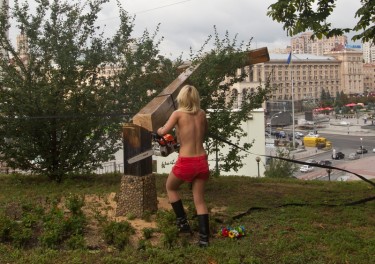On August 17, the Ukrainian radical feminist group Femen chain-sawed a memorial cross in Kiev to protest the conviction of Pussy Riot. As with all their actions, this one was carried out by a topless woman and covered on their blog [1] [ru].
Three days later, Femen published the following statement, which was soon taken down [2] by LiveJournal:
После ошеломляющего дебюта треш-группа “Крестоповал” планирует свой первый гастрольный тур по очагам православного деревянного зодчества России. […] Пили кресты – спасай Россию!
 [3]
[3]Femen activists saw down cross in solidarity with Pussy Riot. In Kyiv, Ukraine, 17 August 2012, photo by ukrafoto ukrainian news, copyright © Demotix.
Five days later, on August 25, unknown parties sawed down three wooden crosses, this time inside Russia, in the city of Chelyabinsk, in the Urals. The same night, another cross came down in Arkhangelsk, in the north. All four were so-called “bowing” or “worship crosses,” that is, crosses set outside church grounds as a memorial, or in commemoration. (A good rundown of how and why they are erected can be found here [4] [ru].) The connection of such copycat vandalism to Femen’s earlier performance seemed clear.
Russian bloggers, however, have taken a different approach, labeling the cross-felling a Kremlin project. This comes as little surprise, given Russia's political tensions and the ease with which Russia’s digital opposition adopts conspiracy theories, despite what is often a complete lack of evidence.
Nikolai Polozov, a Moscow based lawyer, tweeted [5] [ru] the following on August 25:
Позитивно лишь то, что взрывать дома они уже очкуют, ограничиваются крестами.
He was referring to the popular (in some circles) theory that the FSB engineered a series of apartment building bombings in 1999, which led to the second Chechen War. Polozov didn’t waste much time moving straight through to Godwin’s Law [6], soon tweeting [7] that the vandalism of Orthodox crosses is the equivalent of Hitler setting fire to the Reichstag [8].
His tweet was instantly endorsed by Marat Gelman [9], Pussy Riot’s lawyer Mark Feygin [10], as well as Oleg Kashin, who also didn’t mince words [11] [ru]:
Согласен с Полозовым: пиление крестов, конечно, кампания, за кампанией, скорей всего, стоит Кремль.
The idea was stridently repeated in Facebook posts by journalists Sergey Parkhomenko [12] and Andrei Malgin [13]. Both called it a provocation and hinted at dire consequences. Parkhomenko also mentioned the 1999 apartment explosions, while Malgin ominously used the phrase “civil war.” Other bloggers fleshed out the explosion reference. Olga Bakushinskaya recommended [14] [ru] the book “The FSB Blows Up Russia” to those still in doubt, while another blogger conjectured that perhaps the Kremlin would also blow up a church [15] [ru].
Former Kremlin PR wizard Gleb Pavlovsky went further, intimating [16] [ru] that even Femen’s performance was staged by the secret services:
Кто поверит в кресты спиленные в Архангельске и т.п. по указанию Femen (сдающих груди в аренду по договорённости) ? Вонью несёт из московских кабинетов, с прибавлением пары киевских. Схема старая гб-шная […]
Pavlovsky's reading is understandable – after engaging in political scheming for so many years, he probably sees a “political technologist” behind most events.
There is also the vandalism of a recently erected monument to Boris Yeltsin in his home town of Yekaterinburg. The day before the first crosses came down in Russia, someone poured blue paint [17] [ru] all over the enormous statue. Perhaps this, too, is a part of the same Kremlin campaign aimed at passing new anti-desecration laws, muses [18] [ru] blogger fyodorrrrr.
It then comes as no surprise that when one group did finally come forward [19] [ru] to claim responsibility for the cross vandalism, Oleg Kashin and others immediately assumed [20] [ru] it was as a plant by the Kremlin or NASHI. Kashin later wrote [21] [ru]:
Кто-то в Facebook взял на себя ответственность за спиленные кресты — спасибо, конечно, но неужели вы хотите, чтобы мы в это поверили?
The group calls itself Narodnaya Volya, or “Will of the People,” a reference to a populist nineteenth century terrorist organization [22] that managed to assassinate Tsar Alexander II. It describes itself as a movement of “revolutionary-cyberdemocrats” and its Facebook page [23] [ru] is filled with pro-Pussy Riot and anti-government rhetoric.
The evidence that Narodnaya Volya is responsible for anything is flimsy. Of course, if one spends a few minutes looking at its profile, it becomes clear that the group does not seriously expect anyone to believe its claims. The ironic language of their press releases, the lack of any detail beyond that found in the news, and claims of responsibility for defacing the Yeltsin memorial, in addition to the crosses, are only some of the giveaways.
Much more telling is the formula the group first used to explain [24] [ru] how each case of vandalism was mobilized:
летучие боевые отряды оппозиции под названием «Неизвестные»
The final press release added that the mobile combat squads are the “militant wing of our Movement.”
The use of the word “unknown” (which is simply a different way of translating the word “anonymous” into Russian), in conjunction with the Guy Fawkes masks adorning the group’s Facebook page, makes it clear that their claims are tongue-in-cheek. The mobile combat squads are unknown: in other words, they are anonymous. That is, no one knows who they are, including the authors of the press release.
Attribution of collectively anonymous and unrelated actions to a mysterious organization called Anonymous [25] is the hallmark of Internet hacktivists, one which dupes the media time and again. That Russia’s Internet hipsters have yet to grow hip to this is ironic, though irony is of course popular with this crowd.
